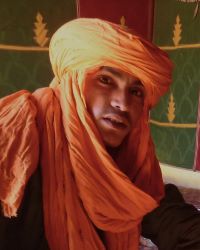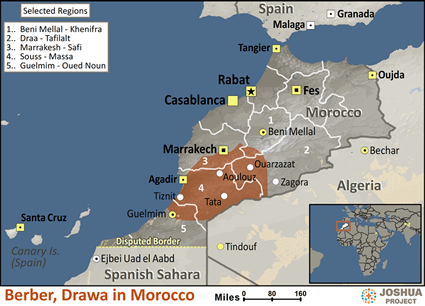The Drawa refer to themselves by the name of their particular subgroup rather than using the term "Berbers". A Berber alphabet, probably derived from the ancient Punic script, has existed for around 2,500 years. Berbers used to be Christians, and St. Augustine was half Berber. The arrival of Arabs in Morocco in the 7th century led to the gradual conversion of some Berbers to Islam. It was not until the thirteenth century, however, with the arrival of large numbers of Arabs from the Middle East, that the majority of Berbers accepted Islam, learned the Arabic language, and were assimilated into Arab culture. Yet, there are various degrees of assimilation. Some are more Arabized while others retain mostly Berber traits. For example, Drawa Berbers usually speak Tachelhit, a Berber language, along with Moroccan Arabic.
Since the Sahara Desert is a harsh environment, most of the Saharan tribes occupy several oases. Drawa Berber economy rests on a fine balance between farming and raising cattle. Every tribe, without exception, depends heavily on domestic animals for carrying heavy loads, milk and dairy products, meat, and hides or wool. No Berber tribe depends on farming for survival. Hunting rarely adds to the food supply.
Drawa Berbers are noted for their skills in various crafts. Domestic tasks such as weaving and pottery are the main work of the women. The men specialize in woodworking, metalworking, and, more surprisingly, fine needlework. Regarding labor, the men do most of the farming, while the women are responsible for milking and gathering.
Drawa Berber societies can be broken down into three basic units: the community, the district, and the tribe. The community is a political collection of clans; the district is a cluster of communities; and the tribe is a group of districts that are characterized by a common territory, name, and culture. Government at the community level is notably democratic. All authority is vested in an assembly called the jemaa. The jemaa, composed of all adult males, usually meets weekly.
In nearly every Berber society, each district, and sometimes each community as well, is divided into two opposing factions called sofs. Membership into the sof is hereditary. Among tribes that no longer live in their original environments, the political units are allied with one another in identical divisions of higher levels known as lefs. Bonds of alliance are re-confirmed by traditional forms of hospitality as well as by huge annual feasts to which members invite one another. If warfare occurs, it is almost exclusively between districts of the opposite lef. However, since lefs are primarily defensive rather than offensive alliances, their primary purpose is to preserve peace in a region.
Like other Berbers, the Drawas are officially Muslim, but they include animistic traditions such as beliefs in the “evil eye” in their form of Islam.
Drawa Berbers need access to the gospel. Their lifestyle and heart language both present challenges in sharing the gospel with them. They need regular gospel radio broadcasts in their Tachelhit language. It's hard for rural people to find gospel materials. A bigger obstacle might be the obstacle of the heart; to them, Christianity is for someone else.
Pray for the Drawa Berbers to learn that a way of forgiveness for their sins has been provided.
Pray that God will overthrow spiritual forces of darkness opposing the spread of his gospel.
There may be no followers of Christ among the Drawa Berbers, but we expect many to be soon born into the faith. Pray they will be filled to the measure of all the fullness of God.
Pray Berbers become aware of their ancient Christian heritage and long to return to it.
Pray for visions and dreams of Jesus.
Pray any Drawa Berber expatriates in Europe come to faith in Jesus and win family members to Christ.
Scripture Prayers for the Berber, Drawa in Morocco.
| Profile Source: Joshua Project |

























